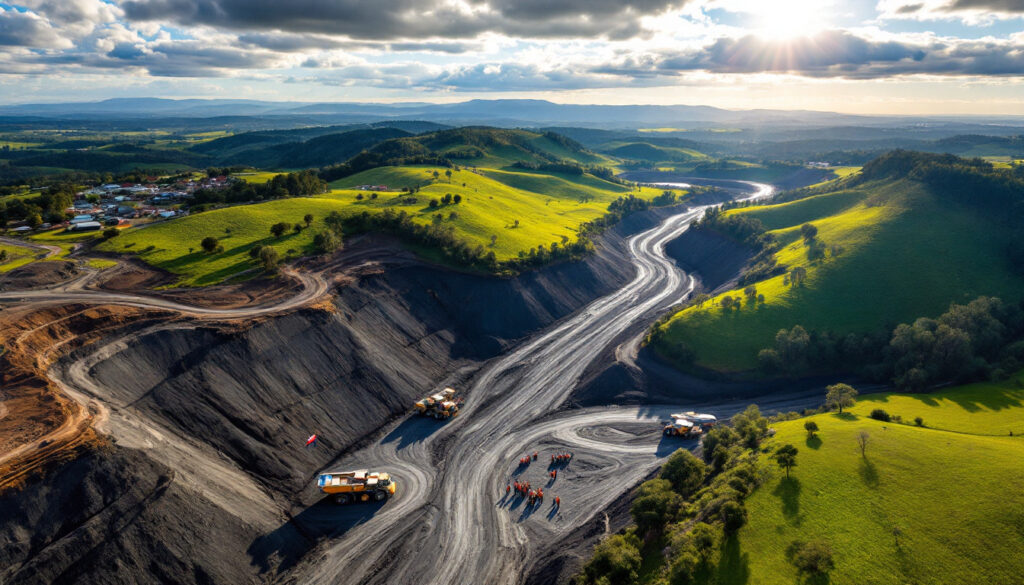Hunter Valley Coal Mine Extension: Saving Jobs Amid Environmental Concerns
The Hunter Valley Operations (HVO) coal mine, a joint venture between Yancoal and Glencore, has been granted an 18-month extension for its HVO North site, extending operations until December 2026. This decision by the NSW Planning Department aims to safeguard 1,500 jobs and sustain economic stability in the Hunter Valley region while the mine pursues a larger continuation project targeting operations until 2050. The extension highlights the ongoing tension between preserving regional employment and addressing environmental concerns, as activists criticize the delay in transitioning away from fossil fuels. This report examines the mine's significance, the rationale behind the Hunter Valley coal mine extension, its implications for workers and the environment, and the broader policy challenges in Australia's energy transition.
What is the Hunter Valley Operations Coal Mine?
Hunter Valley Operations (HVO) is a dual-site coal mining complex located between Singleton and Muswellbrook, jointly managed by Yancoal and Glencore. The mine comprises two operational areas:
- HVO North: Recently granted an 18-month extension until December 2026.
- HVO South: Part of a proposed continuation project seeking approval to operate until 2045.
Key Facts About Hunter Valley Operations
- Employs 1,500 full-time equivalent workers, making it a critical employer in the Hunter Valley.
- Generates substantial revenue through royalties and taxes, contributing to NSW's economy, though exact figures are unspecified in available sources.
- Previously faced closure due to expiring approvals in June 2025, necessitating the recent extension.
HVO's economic footprint extends beyond direct employment, supporting local contractors, businesses, and community services. Dave Foster, HVO's General Manager, emphasized the mine's role in regional stability: "This time extension was necessary to protect the jobs of our workforce and give certainty to our contractors, community partners, and the businesses that rely on us for work in the region".
Why Was the Extension Granted?
The NSW Planning Department approved the 18-month extension based on economic and regulatory assessments:
Economic Considerations
- Job Preservation: The extension secures 1,500 jobs directly tied to HVO North, with indirect benefits for thousands in ancillary industries.
- Regional Stability: Continuity of operations prevents economic disruption in Singleton and Muswellbrook, where local businesses depend on mine-related commerce.
- Revenue Streams: Ongoing operations maintain royalty payments and tax contributions, though specific amounts are not detailed in publicly available documents.
Government Assessment
The NSW Planning Department concluded that environmental impacts could be "minimised and managed" while delivering "benefits for the region and the state". This assessment prioritized short-term economic stability over long-term environmental risks, reflecting the government's balancing act between industry and sustainability goals. Furthermore, despite ongoing net‑zero debates, economic factors often outweigh environmental concerns in mining approvals.
What Does the Extension Mean for Workers?
Job Security and Community Impact
The extension provides immediate relief for workers and their families, many of whom have faced uncertainty since the mine's original 2025 expiration date. Upper Hunter MP Dave Layzell underscored the decision's significance: "For each of those workers, there are families involved… the impact of this extension is huge. It's one of the most important mines in the Hunter Valley". Local businesses, from equipment suppliers to hospitality venues, also gain temporary reprieve from potential closures.
Political Support
Bipartisan backing for the extension underscores coal's political sensitivity in regional NSW. Layzell's characterization of the decision as a "no-brainer" reflects the mine's entrenched role in the local economy. However, this support contrasts with environmental groups' calls for accelerated transition planning. Current coal market challenges have already placed pressure on many mining communities, making extensions politically attractive.
What Are the Environmental Concerns?
Opposition to the Extension
Rising Tide, a local environmental group, condemned the extension as a failure of long-term planning. Activist Alexa Stuart argued: "Either 1,500 workers lose their jobs, or we're forced to continue extending mines… emitting more greenhouse gas emissions that we simply cannot afford in a climate crisis". While the transcript does not quantify emissions, HVO's operations likely contribute significantly to NSW's carbon footprint given its scale.
The Energy Transition Debate
The extension highlights Australia's struggle to reconcile fossil fuel dependency with climate commitments. Critics argue that repeated mine extensions undermine the Paris Agreement targets, while proponents emphasize the socioeconomic risks of abrupt closures. The lack of a clear federal transition strategy exacerbates this tension, leaving regions like the Hunter Valley in policy limbo. Meanwhile, mining decarbonisation efforts across the industry continue to evolve, though at a pace many environmentalists consider insufficient.
What Are HVO's Long-Term Plans?
The Continuation Project
HVO seeks approval to extend operations at HVO South until 2045 and HVO North until 2050, a process delayed by regulatory hurdles. Foster noted: "The HVO Continuation Project is now entering its fifth year of the project approval process… [we] stress the need for regulatory clarity between NSW and the Federal Governments". Delays stem from requests for additional environmental modeling and mine planning insights, reflecting heightened scrutiny of fossil fuel projects.
Regulatory Challenges
Duplication between state and federal approval processes has prolonged the continuation project's timeline. Foster's call for "regulatory clarity" highlights bureaucratic inefficiencies that jeopardize long-term planning for resource-dependent communities. These challenges mirror broader national debates over streamlining approvals for critical minerals versus phased fossil fuel phaseouts.
How Does This Extension Fit Into Australia's Energy Future?
Balancing Jobs and Climate Action
The Hunter Valley coal mine extension exemplifies the dilemma facing policymakers: immediate job retention versus long-term decarbonization. While the mine provides short-term economic stability, it delays investments in renewable energy infrastructure and retraining programs for workers. NSW's reliance on coal royalties—estimated at $3.3 billion annually pre-2025—complicates rapid transitions. Investors seeking mining investment insights must now factor in these policy uncertainties.
Policy Implications
The decision underscores the need for cohesive transition policies, including:
- Regional Investment Funds: Allocating coal royalties to diversify local economies.
- Workforce Retraining: Partnering with TAFE and universities to prepare miners for roles in renewables.
- Emissions Benchmarks: Setting binding targets for methane and CO₂ reductions at existing mines.
Without such measures, ad-hoc extensions risk perpetuating dependence on fossil fuels while failing to address structural economic vulnerabilities. Recent updates on the HVO continuation application show the complex regulatory landscape mine operators must navigate.
FAQ About the Hunter Valley Coal Mine Extension
How long will the Hunter Valley Operations mine now operate?
The recent extension allows HVO North to operate until December 2026, an 18-month extension beyond its previous June 2025 expiration date.
How many jobs were saved by the extension?
Approximately 1,500 full-time equivalent jobs were preserved through the extension decision.
What is the difference between HVO North and HVO South?
HVO North and South are two operational areas of the same mining complex. The current extension applies specifically to HVO North, while both areas are part of the larger continuation project seeking approval to operate until 2045-2050.
What are the next steps for Hunter Valley Operations?
HVO will continue pursuing approval for its larger continuation project while operating under the 18-month extension. This involves providing additional modeling and mine planning information to government authorities. According to ABC News, the company has been working through various environmental requirements during this process.
Conclusion
The Hunter Valley coal mine extension reflects the complex interplay of economic necessity and environmental urgency in Australia's energy transition. While safeguarding 1,500 jobs, the decision defers critical action on climate goals, underscoring the need for proactive policy frameworks. As HVO navigates regulatory hurdles for its 2050 vision, the Hunter Valley's future hinges on balancing immediate livelihoods with sustainable diversification. Policymakers must prioritize transition planning to avoid repeated cycles of short-term extensions and escalating environmental costs.
Ready to Trade on the Next ASX Mining Discovery?
Discover why significant mineral announcements can create substantial market returns by exploring Discovery Alert's dedicated discoveries page, where our proprietary Discovery IQ model helps investors identify actionable opportunities ahead of the broader market.




